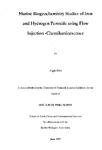Marine Biogeochemistry Studies of Iron and Hydrogen Peroxide using Flow Injection-Chemiluminescence
| dc.contributor.author | Milne, Angela | |
| dc.contributor.other | Faculty of Science and Engineering | en_US |
| dc.date.accessioned | 2013-10-03T12:57:52Z | |
| dc.date.available | 2013-10-03T12:57:52Z | |
| dc.date.issued | 2007 | |
| dc.identifier | NOT AVAILABLE | en_US |
| dc.identifier.uri | http://hdl.handle.net/10026.1/2007 | |
| dc.description.abstract |
Iron is an essential micronutrient for the growth of planktonic species. It is an integral element of numerous enzymes and proteins with important functions in photosynthesis and respiratory electron transport. In contrast to iron, hydrogen peroxide (H202 is ubiquitous in seawater. Phytoplankton are known to generate reactive oxygen species (ROS) such as superoxide and H202 . This production, in conjunction with membrane bound reductases, may affect an organism's ability to access nutrients such as iron. The work presented in this thesis describes the development and optimisation of sensitive flow injection-chemiluminescence techniques to assess redox processes at the cellular level and their application to investigate marine processes. Two flow injection methods, one based on direct sample injection and another involving the preconcentration of iron, were used to determine iron(II) and dissolved iron and assess potential interference from a number of metals and H202. The results demonstrated the increased oxidation of Fe(II) in the presence of H202 (half life reduced from 10.4 to 3.5 min at 50 nM H202 and confirmed the ability of the pre-concentration method to remove this matrix interference. The accuracy and precision of the pre-concentration method were confirmed through analysis of samples collected on two international intercomparison studies. The results demonstrated that the method was precise (- 8 %RSD) and provided a suitably low limit of detection (17 pM) for the determination of dissolved iron. Dust deposition is an important source of iron to remote open ocean regions. The solubility of iron and aluminium in North Atlantic waters was assessed through an on-deck dissolution experiment. Calculated solubilities of iron released from six differing dust samples were low and varied from 0.001 to 0.04 %, whereas the release of aluminium ranged from 0.06 - 9.0 %. Solubility was inversely correlated with particle concentration, where higher solubility was observed for lower particle concentrations. A versatile and adaptable FI system was developed, with a low detection limit (0.4 - 1.3 nM), excellent precision (1.1 - 1.8 %RSD) and the capability of sensitive real-time determination of H202 over a wide dynamic range. The results from laboratory based assays using a novel in-line filter approach demonstrated H202 production by the diatom species Thalassiaira ueiss weissflogii with observed concentrations in the range 30- 100 nM. In addition, through field studies carried out in two different oceanic regions (English Channel and Ross Sea), a previously unreported correlation between phytoplankton biomass and surface H20 1 concentrations was observed. The FI-CL instrumentation for the determination of Fe(II) was successfully adapted and optimised for the continuous in-line measurements of Fe(II) generated by diatoms. This technique provided a low detection limit (11 pM) and excellent precision (6.3 ± 3.2 % RSD). In further laboratory based assays with T. ueissflogii, preliminary results indicated pM changes in Fe(II) generation following the reduction of organically bound Fe(Ill). | en_US |
| dc.description.sponsorship | Marine Biological Association | en_US |
| dc.language.iso | en | en_US |
| dc.publisher | University of Plymouth | en_US |
| dc.title | Marine Biogeochemistry Studies of Iron and Hydrogen Peroxide using Flow Injection-Chemiluminescence | en_US |
| dc.type | Thesis | |
| plymouth.version | Full version | en_US |
| dc.identifier.doi | http://dx.doi.org/10.24382/4586 |
Files in this item
This item appears in the following Collection(s)
-
01 Research Theses Main Collection
Research Theses Main


